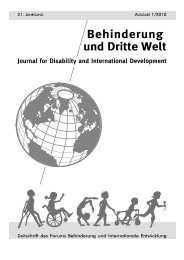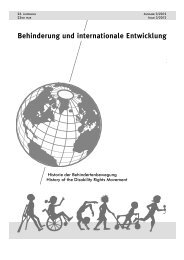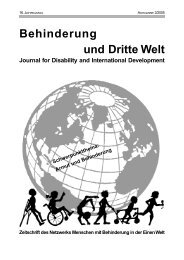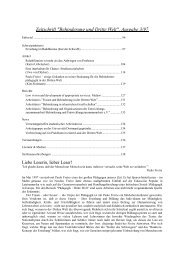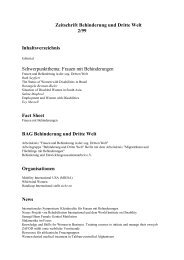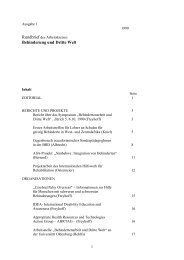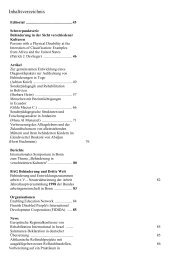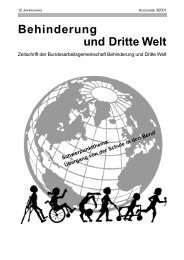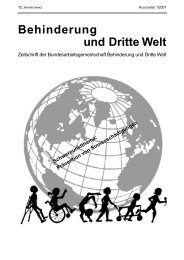Zeitschrift Behinderung und Dritte Welt
Zeitschrift Behinderung und Dritte Welt
Zeitschrift Behinderung und Dritte Welt
Create successful ePaper yourself
Turn your PDF publications into a flip-book with our unique Google optimized e-Paper software.
S CHWERPUNKTTHEMA2000). Girls attend school on even a more infrequentbasis than boys with disabilities (DfID2000). Even when women with disabilities areengaged in paid work, they earn lower incomesthan other women, hardly sufficient to make anadequate living (UNESCAP 1995). All of thisadds to the perception that they are burdens ontheir family and society, rather than people withthe same potential, given the opportunity forequal participation.Women with disabilities are not adequatelyrepresented in organizations of people with disabilities(DPOs). Studies suggest that althoughpresent, they are less likely to be leaders or decision-makersof DPOs (UNESCAP 1995). MaleDPO leaders in charge of setting advocacyagendas can certainly raise issues of commoninterest to men and women with disabilities,such as access to infrastructure and education,but cannot adequately capture the genderedexperience of disability or the unique barriersfaced by women with disabilities. Anecdotally,livelihood, for example, is often expressed as apriority advocacy area, whereas access to reproductivehealth and education is not.Organizations representing women havealso yet to engage adequately with the uniqueexperiences of women with disabilities. Key issuessuch as poverty, gender-based violence,and barriers to reproductive health care, nodoubt affect women with disabilities as well. Butexperienced in conjunction with disability, barriersto support and other appropriate servicesare magnified for women with disabilities. Forexample, some studies, such as one conductedwith women with disabilities in the Indian stateof Orissa indicate that experiences of violenceare ubiquitous in their daily lives (Mohapatraand Mohanty 2004). Evidence from developedcountry settings suggests that women with disabilitiesare more likely to use permanentmethods of contraception such as hysterectomiesand tubal ligation, with involuntary sterilizationstill in evidence (Fiduccia and Wolfe1999). Suboptimal reproductive health practicesare likely to occur to an even greater extentin developing country contexts wherewomen with disabilities are less likely to knowabout the different options available to them,but are rarely included in reproductive healtheducation programs (UNESCAP 1995). Physicalbarriers to services, communication barriers forinclusion in awareness-raising programs andattitudinal barriers are all examples of howwomen with disabilities experience difference.In addition, women with disabilities are oftenunaware of their own right to control theirsexuality, and education on these rights is onearea where empowering women with disabilitieswould make a huge impact on their abilityto control life choices (CBM 2007).Advocates of women with disabilities suggestthat the self-defined needs of women with disabilitiesremain on the margins of the socialjustice movement, leaving their voices unheardand their views invisible (Fiduccia and Wolfe1999). Sands (2005), reflecting on experiencesfor women with disabilities in the Pacific region,writes that the interconnection between disabilityand gender remains invisible withinwomen’s rights, disability and development.This is particularly evident for women of the Pacificregion where they have not been recognizedas a development priority.Some agencies in the region, amongst them,the Asian Development Bank (ADB) and theAustralian Aid Agency for International Development(AusAID) are beginning to realize thatdisability is an important concern of thewomen’s rights movement, as is gender to thedisability movement.Inclusion of Women with Disabilitiesin Gender PoliciesAusAID’s gender policy aims to advance equalityand empower women as an overarchinggoal of the aid program (AusAID 2007). Thepolicy focuses on improving women’s economicstatus, facilitating access to health care andeducation, and increasing women’s leadershipthrough the promotion of a human rightsframework (AusAID 2007). Although equity,empowerment, access to health care and educationare also important issues for women withdisabilities, no mention is made of how theywere consulted in policy development, or ofhow they will be included in policy outcomes.In a recent audit of its development effectivenessprogram, AusAID recognized that inkey areas such as women’s leadership, the reductionof violence, maternal mortality andmorbidity, results in the Asia-Pacific region havebeen disappointing for all women (AusAID2008). Millennium Development Goals aro<strong>und</strong>maternal mortality are far from achieved andhalf a million women continue to die each yearfrom pregnancy related causes (UN MillenniumProject 2005). A further 20 million women sustaininjuries that, left untreated, can lead topermanent disabilities, an example of which isobstetric fistula (UNFPA 2003). This means thatprevention of disability targets aro<strong>und</strong> maternityare not being met either.Concerns that women with disabilities arenot well integrated into regional policies have30 <strong>Zeitschrift</strong> <strong>Behinderung</strong> <strong>und</strong> <strong>Dritte</strong> <strong>Welt</strong> 3/2009



